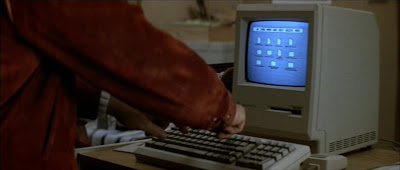Movies can be time capsules, especially where technology is concerned. My kids have been watching the Toy Story movies lately, and I was struck by how the second film, which came out in 1999, pays homage to one discarded technology while taking for granted the existence of another technology that has, itself, fallen by the wayside in the decade since that movie came out.
First, the discarded technology: In one scene, Woody discovers a vintage 1950s record player that happens to bear his image, and he exclaims, “A record player! I haven’t seen one of these in ages.”
Next, the technology taken for granted: Woody, Jessie and Bullseye watch old episodes of Woody’s Roundup on videotape — and they sit on videocassette cases while doing so — presumably oblivious to the fact that a brand-new technology called DVDs is about to drive videotapes out of business:
Pixar itself was familiar with DVDs by this point, of course; around the time Toy Story 2 came out in theatres, A Bug’s Life (1998) came out on DVD, and Pixar proudly proclaimed that that was the first animated DVD to be taken straight from the digital source. One year later, the first two Toy Story movies would be packaged in a three-disc “Toy Box” set that, combined with the three-disc Fantasia (1940-1999) set, was one of the main reasons I got my first DVD player during the Boxing Day sales of 2000.
But it wasn’t until a few years later that DVDs surpassed VHS as the format of choice for the average home-video consumer. So within the Toy Story 2 storyline, it made perfect sense for the characters to be watching videotapes. They just wouldn’t be watching them for very much longer, is all.
And now for something completely different: I recently watched Star Trek IV: The Voyage Home (1986) for the first time in years, and I was struck once again — as I often am while watching movies set during that decade — by how primitive some things from that era seem to me now.
Take, for example, the newspapers we see in one scene, and the screen on the Apple MacIntosh computer that we see in another scene. They’re both in black-and-white! And yet, I can still remember how fake and “advanced” it seemed back then, when Scotty finished typing on the MacIntosh’s keyboard and the image on its screen began to rotate — as though the average office computer would be capable of such a thing!
While the black-and-white images would seem primitive to me in any film from the 1980s, they seem especially primitive in this film, since the Star Trek movies at that time were on the cutting edge of computer graphics. The “Genesis Planet” footage from Star Trek II: The Wrath of Khan (1982) — animated by the team that would go on to become Pixar! — was so good that the next two sequels, including The Voyage Home, re-used it. And The Voyage Home itself added to the mix by including one of the earliest examples of “morphing” in a mainstream film, during that trippy time-travel sequence in which the faces of Kirk and his crew seem to blend into one another.
But of course, the technology that made those images possible was completely inaccessible to the average person at that time; even the MacIntosh depicted above, primitive as it seems to us now, would have cost about $2,500 back then. (After adjusting for inflation, that’s apparently over $5,000 in today’s dollars.) So a story set in average homes and average offices had to settle for props like these.
One can only wonder how dated today’s movies will look in a decade or so. And how these real-world changes may or may not be reflected in Toy Story 3 when it comes out next year, nearly eleven years after the previous movie in that series.
















